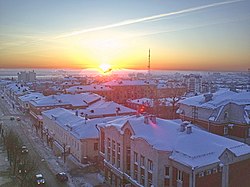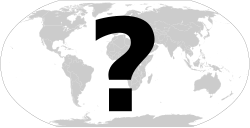Kirov, Kirov Oblast
Kirov (Russian: Киров) is a city in and the capital of Kirov Oblast in Russia. As of 2020, the city has 518,348 people. It is a historical, cultural, industrial, and scientific center of Priural'e. This city is home to the Dymkovo toys.
| Kirov (English) Ки́ров (Russian) | |
|---|---|
| - City[1] - | |
 View of Kirov | |
 | |
| Anthem | none[2] |
| City Day | observed in June[3] |
| Administrative status | |
| Country | Russia |
| Federal subject | Kirov Oblast[1] |
| Administratively subordinated to | City of Kirov[1] |
| Municipal status | |
| Urban okrug | Kirov Urban Okrug[4] |
| Head[6] | Kovaleva Elena[5] |
| Representative body | City Duma[7] |
| Statistics | |
| Area | 757.0 km2 (292.3 sq mi)[8] |
| Population (2010 Census, preliminary) | 473,695 inhabitants[9] |
| - Rank in 2010 | 38th |
| Density | 626/km2 (1,621/sq mi)[10] |
| Time zone | MSK (UTC+04:00) |
| Founded | 1374[11][12] |
| Postal code(s) | 610000–610002, 610004–610011, 610013–610021, 610025–610027, 610029–610031, 610033, 610035, 610037, 610040, 610042, 610044–610048, 610050, 610051, 610890, 610899, 610960–610967, 610990, 610995, 610999 |
| Dialing code(s) | +7 8332 |
| Official website | |
History
- The principality and republic
The native Slavic tribe of Central Russia and the Volga regions, the Vyatichis. They mixed with the Novgorodian Slovenes and Finno-Ugric people. According to the medieval chronicles, the first settlements of Russia in the area appeared in the 12th century. Kirov was first mentioned as Vyatka for the first time in 1374 when Novgorod ushkuyniks plundered it on their way to Bolghar. Vyatka was governed by a veche as other Northern Russian republics of Pskov Oblast and Novgorod Oblast. At different times in the late 14th and 15th centuries Vyatka militias raided Ustyug, Novgorod and Tatar lands on Kama and Volga. Vyatka supported Yury of Zvenigorod during the Muscovite Civil War and after his party lost the victorious Vasily II sent Muscovite armies twice against Vyatka to subjugate it and eventually it was forced to accept the suzerainty of Moscow while retaining a significant measure of autonomy. In 1469 Vyatka allied with Khan Ibrahim of the Khanate of Kazan and did not take part in the campaign of Ivan III against the khanate.
After several unsuccessful campaigns by Moscow against Vyatka in 1480s, the latter was finally annexed in 1489.
- Part of the Grand Duchy of Moscow and the Russian Empire
Khlynov became known throughout Russia for its clay small statues and whistles. Kirov's oldest surviving monument is the Assumption Cathedral (1689), an imposing structure inhabiated by 5 globular domes.
In 1780, Catherine the Great renamed the town Vyatka and made it the seat of Vyatka Governorate. Kirov also served as a place of exile, notably for Alexander Herzen, Alexander Vitberg, and Mikhail Saltykov-Shchedrin. By the end of the 19th century, it was an important train station on the Trans-Siberian railway.
- Soviet and post-Soviet period
In December 1934, Kirov was renamed after a leader of the Soviet Union, Sergey Kirov, who was assassinated on December 1, 1934. However, whilst the name Kirov has remained since the end of the Soviet Union, some institutions such as the university bear the former name of Vyatka.
Geography
Kirov was located on the Vyatka River of the European part of Russia. It is 896 kilometers northeast of Moscow, 1,384 kilometers southeast of Saint Petersburg, 576 kilometers northeast of Nizhny Novgorod, and 851 kilometers northwest of Yekaterinburg.
Gallery
Kirov, Kirov Oblast Media
References
- ↑ 1.0 1.1 1.2 Law #387-ZO
- ↑ Article 4 of the Charter of Kirov states that the city will have an anthem once one is officially adopted. As of 2016, an anthem is not listed among the symbols of the city shown on the official website of Kirov Archived 2017-06-09 at the Wayback Machine.
- ↑ Charter of Kirov, Article 4
- ↑ Cite error: Invalid
<ref>tag; no text was provided for refs namedRef241. - ↑ Official website of Kirov.Kovaleva was elected head of the city of Kirov[dead link], Head of Kirov (in Russian)
- ↑ Charter of Kirov, Article 28
- ↑ Charter of Kirov, Article 22
- ↑ Official website of Kirov. Administrative-Territorial Structure Archived 2016-11-30 at the Wayback Machine (in Russian)
- ↑ "Всероссийская перепись населения 2010 года. Том 1[[Category:Articles containing Russian-language text]][[Category:Lang and lang-xx using deprecated ISO 639 codes|ru]]". Всероссийская перепись населения 2010 года (2010 All-Russia Population Census) (in Russian). Federal State Statistics Service. 2011. Retrieved June 29, 2012.
{{cite web}}: Check date values in:|accessdate=(help); no-break space character in|accessdate=at position 9 (help); Unknown parameter|trans_title=ignored (|trans-title=suggested) (help); URL–wikilink conflict (help)CS1 maint: unrecognized language (link) - ↑ The value of density was calculated automatically by dividing the 2010 Census population by the area specified in the infobox. Please note that this value may not be accurate as the area specified in the infobox does not necessarily correspond to the area of the entity proper or is reported for the same year as the population.
- ↑ Official website of Kirov. Brief Historical Reference Archived 2022-01-26 at the Wayback Machine (in Russian)
- ↑ Энциклопедия Города России. Moscow: Большая Российская Энциклопедия. 2003. pp. 193–195. ISBN 5-7107-7399-9.














